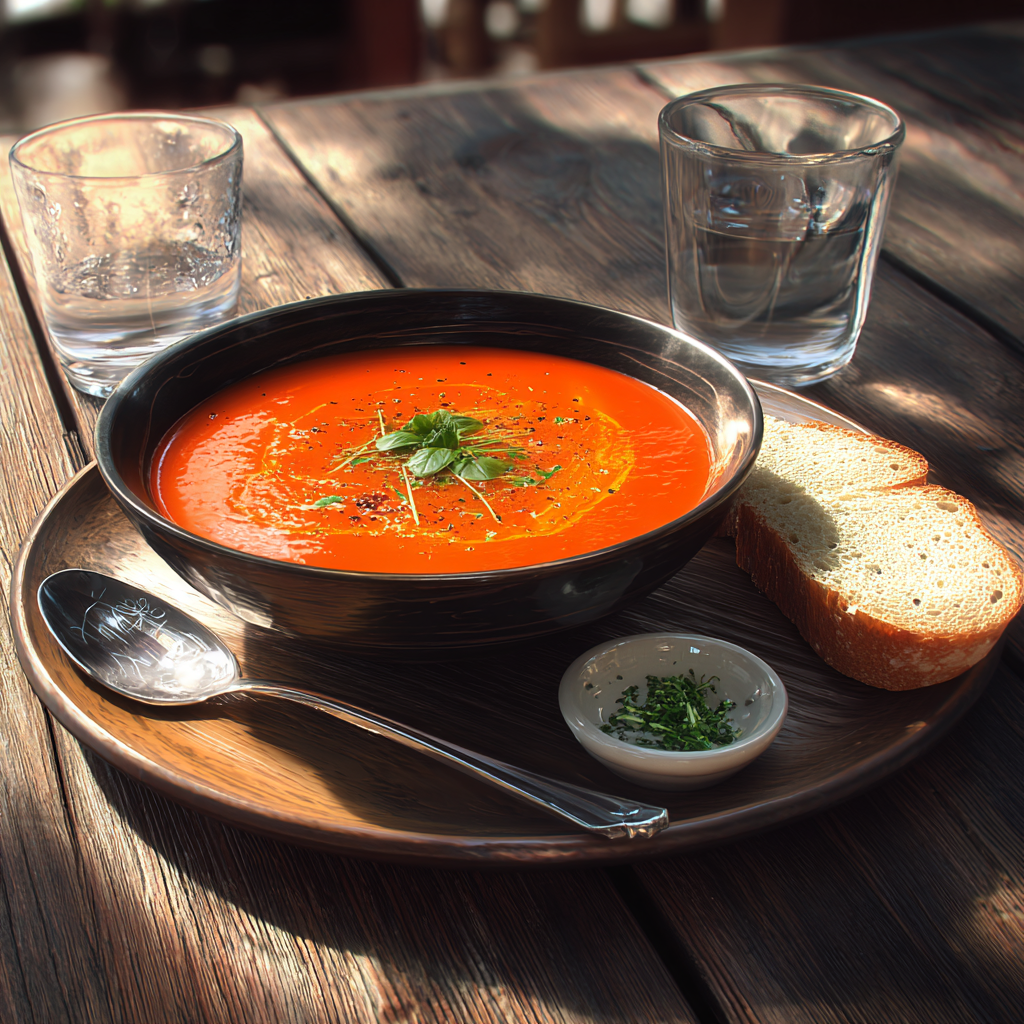Introduction
I love cooking. There’s something magical about turning simple ingredients into a dish that warms the soul. For me, nothing beats a comforting bowl of tomato soup on a chilly day. It’s creamy, tangy, and just feels like home. I’ve spent years perfecting my recipes, and today, I’m sharing one of my favorites—the 4BS tomato soup recipe. It’s quick, easy, and packed with flavor.
This soup is special because it uses only four main ingredients. Yes, you heard that right—just four. Yet, it delivers restaurant-quality taste without the fuss. Whether you’re new to cooking or a seasoned pro, this recipe is for you. By the end of this article, you’ll know the secret behind the four key ingredients, how to make your soup more filling, and tips to avoid common mistakes. Plus, I’ll answer some FAQs to clear up any confusion.
The Magic of 4 Ingredients in Tomato Soup
What Are the 4 Ingredients in Tomato Soup?
Let’s break it down. The 4BS tomato soup recipe relies on tomatoes, broth, butter, and seasoning. That’s it. These ingredients might seem basic, but together, they create pure comfort in a bowl.
- Tomatoes: They’re the star of the show. Fresh or canned, tomatoes give the soup its rich, tangy flavor. I prefer using canned San Marzano tomatoes because they’re sweeter and less acidic.
- Broth: This adds depth and balances the acidity of the tomatoes. Chicken or vegetable broth works well, depending on your preference.
- Butter: A little goes a long way. Butter makes the soup velvety and adds a hint of richness that ties everything together.
- Seasoning: Salt, pepper, and maybe a pinch of sugar are all you need. Seasoning enhances the natural flavors without overpowering them.
Here’s a personal tip: Always choose high-quality ingredients. I’ve learned from experience that better ingredients mean better taste. For example, using fresh herbs instead of dried ones can elevate your soup instantly.
Prepping Your Ingredients
Efficiency is key when prepping ingredients. Start by gathering everything you need. This saves time and keeps your kitchen organized. Here’s how to prep each ingredient:
- Tomatoes: If you’re using fresh tomatoes, blanch them first. Boil water, drop the tomatoes in for 30 seconds, then plunge them into ice water. The skins will slip off easily. For canned tomatoes, simply crush them with your hands or a spoon.
- Broth: Warm it slightly before adding it to the pot. This helps blend the flavors faster.
- Butter: Cut it into small cubes so it melts evenly.
- Seasoning: Measure out your salt, pepper, and sugar beforehand. Adjust as you go—you can always add more later.
If you want to experiment, try swapping vegetable broth for chicken broth to make the soup vegetarian-friendly. You could also stir in a splash of cream at the end for extra richness. Just remember, simplicity is what makes this 4BS tomato soup recipe shine.
One mistake I often see is overcomplicating things. People toss in too many extras, like heavy spices or multiple vegetables, which can mask the natural goodness of the tomatoes. Stick to the basics unless you’re confident about substitutions.
Another thing to keep in mind is texture. Some folks wonder what thickens tomato soup. In this recipe, it’s the natural consistency of the tomatoes and butter. You don’t need flour or cornstarch. Simmering the soup reduces the liquid and intensifies the flavors naturally.
To wrap up this section, here’s a quick recap of what we’ve covered:
- The four core ingredients: tomatoes, broth, butter, and seasoning.
- Tips for choosing quality ingredients to boost flavor.
- How to prep efficiently and ideas for substitutions.
- Avoiding unnecessary add-ins that can ruin the soup’s balance.
Next, I’ll dive deeper into making your 4BS tomato soup recipe more filling and satisfying. Stay tuned!
Step-by-Step Instructions for the 4BS Tomato Soup Recipe
Alright, let’s get into the fun part—actually making this soup. Trust me, it’s as easy as it gets. I’ve made this recipe so many times that I can practically do it with my eyes closed (though I wouldn’t recommend that). Here’s how to whip up your own batch of 4BS tomato soup recipe in no time.
First things first, grab a medium-sized pot. Heat it over medium heat and toss in your butter. Let it melt slowly, swirling it around until it coats the bottom of the pot. This is where the magic begins. Butter has this way of setting the stage for rich, creamy flavors, almost like a warm hug for your taste buds.
Once the butter’s melted, add your tomatoes. If you’re using canned ones, crush them right into the pot. Fresh tomatoes? Chop them up beforehand. Stir everything together and let it simmer for about 5 minutes. You’ll start noticing this amazing aroma filling your kitchen. It’s one of those smells that just feels like comfort.
Next, pour in your broth. Remember how we talked about warming it earlier? This little trick helps the flavors meld faster. Give it a good stir, and let it come to a gentle boil. Then, lower the heat and let it simmer for about 15 minutes. Keep an eye on it—stir occasionally to make sure nothing sticks to the bottom.
Here’s where seasoning comes in. Sprinkle in some salt, pepper, and maybe a pinch of sugar if your tomatoes are too tangy. Funny enough, I once forgot to add sugar, and the soup turned out fine, but it lacked that perfect balance. So, double-check your seasoning before serving—it’s a game-changer. Taste as you go; your palate knows best.
After 15 minutes, turn off the heat. If you want a silky-smooth texture, grab an immersion blender and blend the soup until it’s velvety. No immersion blender? No problem. Carefully transfer the soup to a regular blender in batches. Just be careful—it’s hot!
And voila! Your 4BS tomato soup recipe is ready. Wasn’t that quick? From start to finish, it takes less than 30 minutes. Perfect for busy weeknights or lazy Sundays when you need something cozy but don’t want to spend hours in the kitchen.
What to Add to Tomato Soup to Make It More Filling?
Now, here’s the thing. While this soup is delicious on its own, sometimes you want something a little heartier. Maybe it’s lunchtime, and you need something more substantial to keep you going. Or maybe you’re feeding a crowd and want to stretch the recipe further. Either way, I’ve got you covered.
One of my favorite tricks is adding a splash of cream. Heavy cream works wonders, but half-and-half or even coconut milk (for a dairy-free option) does the job too. Stir it in during the last few minutes of cooking, and suddenly your soup feels richer and more indulgent. It’s like giving your soup a little upgrade. By the way, this tip works great with other soups too, like the Longhorn potato soup recipe.
If you’re looking to bulk it up even more, try tossing in some cooked pasta or beans. Small pasta shapes like ditalini or orzo are perfect—they soak up the flavors and add a nice chewy texture. Beans, like cannellini or chickpeas, are another fantastic option. They’re nutritious, filling, and pair beautifully with the tanginess of the tomatoes. For inspiration, check out the Carrabba’s lentil soup recipe, which uses lentils in a similar way.
Another fun idea? Grilled cheese croutons. Yes, you read that right. Take leftover grilled cheese sandwiches, cut them into cubes, and toast them in the oven until crispy. Sprinkle them on top of your soup for a crunchy twist. It’s like having a bowl of nostalgia in every bite. Speaking of nostalgia, have you tried the Goya split pea soup recipe? It’s another comforting classic.
Lastly, don’t underestimate the power of toppings. A dollop of sour cream, a sprinkle of Parmesan, or some fresh basil leaves can take your soup from good to great. These little extras not only enhance the flavor but also make your dish look Instagram-worthy.
Common Mistakes When Making Tomato Soup
What Are Some Common Mistakes When Making Tomato Soup?
Let’s talk about the hiccups people often encounter when making tomato soup. I’ve been there, done that, and learned the hard way. But hey, mistakes are just lessons in disguise, right?
One biggie is under-seasoning. Tomatoes can be pretty acidic, and without enough salt or a touch of sweetness, the soup might taste flat. Always taste as you go—I can’t stress this enough. If it tastes bland, chances are it needs more salt or a pinch of sugar. Trust your instincts.
Another common error? Using low-quality canned tomatoes. Not all tomatoes are created equal. I’ve had batches where the soup turned out watery or overly sour because the tomatoes weren’t up to par. Stick with reputable brands like San Marzano if you can. They’re worth the extra dollar or two.
Overcooking is another pitfall. Simmering the soup for too long can mute the bright, fresh flavors of the tomatoes. Fifteen minutes is usually plenty. Any longer, and you risk losing that vibrant taste. On the flip side, undercooking can leave the flavors feeling raw and unbalanced. Timing is everything.
Here’s a funny story: Once, I accidentally burned the butter at the very beginning. Rookie mistake, I know. The whole batch smelled smoky, and I had to start over. Lesson learned—keep an eye on that butter! If you’re new to cooking, the Carrabba’s chicken noodle soup recipe is a forgiving place to practice your skills.
Finally, resist the urge to overcomplicate things. I’ve seen recipes calling for tons of spices, herbs, and extras. Sure, they sound fancy, but they can overwhelm the simplicity of a good tomato soup. Stick to the basics unless you’re confident about what you’re adding. Less really is more here.
In summary, avoid these common pitfalls:
- Under-seasoning—always taste and adjust.
- Low-quality tomatoes—invest in good ones.
- Overcooking or undercooking—find the sweet spot.
- Burning the butter—watch it closely!
- Adding too many extras—keep it simple.
With these tips in mind, you’re well on your way to mastering the 4BS tomato soup recipe. Happy cooking!
Thickening Your Tomato Soup Naturally
Here’s the thing about tomato soup—sometimes it just needs a little extra oomph in the texture department. I’m not talking about turning it into baby food or a brick, but finding that sweet spot where it’s creamy and hearty without being too watery. You might be wondering, “What is the thickener in tomato soup?” Well, let me tell you, there are plenty of ways to thicken it naturally, no funky powders required.
One method I absolutely swear by is blending part of the soup. It’s so simple, yet it works like a charm. After you’ve simmered everything together, grab your immersion blender (or transfer a portion to a regular blender) and blend about a third of the batch. This creates a velvety texture while still leaving some chunkiness if that’s your thing. By the way, this trick isn’t just for tomato soup—it’s a lifesaver for soups like homemade chili recipes too.
Another go-to trick is making a quick roux. Now, before you roll your eyes and think, “Isn’t that fancy?”—it’s actually super easy. Melt a tablespoon of butter in a small pan, whisk in an equal amount of flour, and cook it for a minute or two until it smells nutty. Slowly stir this mixture into your soup, and boom—you’ve got thickness. Just don’t overdo it; a little goes a long way. Funny enough, I once tried adding way too much roux, and my soup ended up tasting like bread pudding. Lesson learned!
If you’re looking for something even simpler, simmering the soup uncovered for a few extra minutes does wonders. The liquid reduces naturally, concentrating the flavors and thickening the soup at the same time. I love this method because it feels kind of hands-off, and honestly, who doesn’t love multitasking while dinner practically makes itself?
Serving Suggestions and Pairings
Let’s talk about how to serve this masterpiece. Tomato soup is one of those dishes that pairs beautifully with so many things, but my favorite combo will always be a slice of crusty bread. There’s just something about dipping warm, buttery bread into a bowl of creamy tomato soup that feels downright magical. If you’re feeling fancy, try brushing the bread with olive oil, sprinkling it with garlic powder, and toasting it in the oven for a DIY crostini situation.
For a lighter option, pair the soup with a fresh salad. A simple green salad with balsamic dressing complements the tangy richness of the soup perfectly. Or, if you’re feeding a crowd, whip up some gooey grilled cheese sandwiches. Pro tip: Use a mix of sharp cheddar and mozzarella for maximum meltiness. Cut them into triangles because, let’s face it, they just taste better that way.
Here’s a fun idea I recently tried—serve the soup in a bread bowl. Yes, it’s indulgent, but sometimes you need to treat yourself. Hollow out a round loaf of sourdough, fill it with the soup, and sprinkle some fresh herbs on top. It’s a showstopper at parties and Instagram gold. Speaking of herbs, I can’t stress enough how much a sprinkle of fresh basil or parsley elevates the dish. It adds color, freshness, and a pop of flavor that ties everything together.
FAQ Section
What are the 4 ingredients in tomato soup?
The 4BS tomato soup recipe relies on tomatoes, broth, butter, and seasoning. These four simple ingredients create a rich, comforting bowl of soup that’s hard to beat. Stick to high-quality versions of each for the best results.
What to add to tomato soup to make it more filling?
To bulk up your soup, stir in cooked pasta, beans, or a splash of cream. Grilled cheese croutons or toppings like sour cream and Parmesan also add substance and flair. These extras make the soup heartier without compromising its simplicity.
What are some common mistakes when making tomato soup?
Under-seasoning, using low-quality tomatoes, and overcooking are frequent pitfalls. Burning the butter or adding too many extras can also throw off the balance. Keep it simple, season thoughtfully, and watch your timing for the best results.
What is the thickener in tomato soup?
Natural thickeners include blending part of the soup, reducing the liquid by simmering, or using a roux. These methods enhance the texture without masking the soup’s natural flavors. Avoid over-thickening—it should still feel light and comforting.
Can I use fresh tomatoes instead of canned?
Absolutely! Fresh tomatoes work great, especially if they’re ripe and flavorful. Blanch and peel them first for easier blending. However, canned San Marzano tomatoes are a convenient alternative, offering consistent sweetness and acidity.
Is this recipe vegetarian-friendly?
Yes, simply swap chicken broth for vegetable broth. You can also use plant-based butter if needed. These swaps keep the recipe accessible for vegetarians while maintaining its deliciousness.
How long does tomato soup last in the fridge?
Store leftover soup in an airtight container for up to 3-4 days. Reheat gently on the stovetop, adding a splash of broth if it thickens too much. Freezing is another option—just thaw and reheat when ready to enjoy again.
What herbs pair well with tomato soup?
Basil, thyme, and oregano are classic choices. For a twist, try rosemary or a bay leaf during cooking. Fresh herbs as garnish add brightness and elevate the final presentation.
Can I make this recipe in a slow cooker?
Definitely! Combine all ingredients in the slow cooker and cook on low for 6-8 hours. Blend before serving for a smooth texture. This method allows flavors to develop slowly, resulting in an even richer soup.
Why is my tomato soup too acidic?
Acidity often comes from underripe tomatoes or lack of balance. Add a pinch of sugar or a splash of cream to counteract it. Taste as you adjust—it’s all about finding harmony between sweet, tangy, and savory notes.
Conclusion
There’s something special about the 4BS tomato soup recipe. It’s not just about the simplicity or the incredible flavor—it’s about the memories it creates. Whether it’s a cozy night in or sharing a bowl with loved ones, this soup has a way of bringing people together. So go ahead, give it a try. And when you do, I’d love to hear how it turns out. Tag me in your pics or drop me a note—I’m always here to chat about food!
Oh, and if you enjoyed this recipe, don’t forget to check out more of my simple, soul-warming soups and stews. Happy cooking, friends!

4BS Tomato Soup Recipe
Ingredients
Equipment
Method
- Heat a medium-sized pot over medium heat and melt the butter until it coats the bottom of the pot.
- Add the tomatoes to the pot, crushing them if they're canned, or chopping them if they're fresh.
- Stir the mixture and let it simmer for about 5 minutes until aromatic.
- Pour in the warmed broth and stir well.
- Allow the mixture to come to a gentle boil, then reduce the heat and let it simmer for about 15 minutes, stirring occasionally.
- Taste and adjust the seasoning with salt, pepper, and sugar as needed.
- Turn off the heat and blend the soup to a velvety texture using an immersion blender or by carefully transferring it to a regular blender in batches.
- Serve hot and enjoy!


